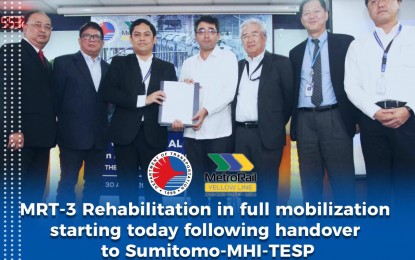MANILA – Sumitomo Corporation, its technical partner, Mitsubishi Heavy Industries (MHI), and MHI’s fully-owned Philippine subsidiary, TES Philippines (TESP), formally took over on Wednesday the reins of the comprehensive rehabilitation and maintenance of the Metro Rail Transit 3 (MRT-3).
This, after the MRT-3 Maintenance Transition Team (MTT) handed over the task to the private contractor in a ceremony on Tuesday at the MRT-3 Depot in Quezon City.
Starting Wednesday, Sumitomo-MHI-TESP will handle all rehabilitation and maintenance works for MRT-3 to restore the railway system back to its original design condition.
During the ceremony, the MTT formalized the transfer of documents to Sumitomo-MHI-TESP as the new rehabilitation and maintenance service provider for the railway line.
Department of Transportation (DOTr) Secretary Arthur P. Tugade congratulated the official turnover to Sumitomo-MHI-TESP, noting that the strong partnership between the Philippines and Japan will result in much-improved operations and services for the passengers of MRT-3.
“As we celebrate today’s milestone, let us remember that there is still a lot of work ahead of us. We aim to restore the MRT-3 – currently our main mass transit – to its high-grade design condition, in the hope that we can look to the future and improve on its infrastructure,” Tugade said.
The hand-over ceremony for the rehabilitation and maintenance works was led by DOTr Undersecretary for Railways Timothy John Batan, together with Japan International Cooperation Agency (JICA) Chief Representative Yoshio Wada, MRT-3 General Manager Rodolfo Garcia, MRT-3 Director for Operations and Maintenance Transition Team Head Michael Capati, Sumitomo Infrastructure Department Director and General Manager Masanori Honda, MHI Engineering Project Manager Koji Nishiyama, and TESP Chairman Kiyoshi Morita.
Japanese railway expertise
Under the MRT-3 Rehabilitation Project, Sumitomo-MHI-TESP will undertake the overhaul of all of MRT-3’s 72 Light Rail Vehicles (LRVs), replace all mainline tracks, rehabilitate power and overhead catenary systems, upgrade signaling, communications and CCTV systems, and repair all of MRT-3’s escalators and elevators, among other system repairs and improvements.
As the original designer, builder, and maintenance provider of the MRT-3 for 12 years, Sumitomo-MHI-TESP brings with it an extensive track record in railway engineering, construction, and maintenance, and is best fit for the challenging task of restoring MRT-3 to its design condition.
As early as end-2018, Sumitomo-MHI-TESP has already conducted advance transition works for the rehabilitation project.
In February 2019, ahead of receiving any advance payment, it began procurement of tracks, train parts, and other necessary components for the comprehensive rehabilitation and maintenance of MRT-3.
The project will last for 43 months, with rehabilitation works slated for completion within the first 26 months.
It is expected that the MRT-3 Rehabilitation Project will increase the number of operating trains during peak hours from 15 to 20, double operating speed from 30 to 60 kilometers per hour, and cut by half the time between trains from 7-10 minutes to 3.5 minutes.
Wada said Sumitomo-MHI-TESP is ready to begin maintenance works to provide efficient and reliable service as well as comfort to commuters.
“Railway networks symbolize progress, and mark a significant chapter in every country’s development history. Through Japanese technology and standards that Sumitomo Corporation, with support from Mitsubishi Heavy Industries, will share, we are confident that this railway line will become safer and more reliable,” he said.
MTT members lauded
At the hand-over ceremony, MTT members were also recognized for their efforts to tide over the maintenance of the MRT-3 pending the recent mobilization of MRT-3’s new maintenance service provider.
The MTT was the first government-based maintenance team for the MRT-3 since it started operations in 1999 as maintenance of the said rail line had always been outsourced to a third party private provider.
Under the MTT supervision, unloading incidents in 2018 dropped to 74, with only 10 incidents occurring in the first quarter of 2019 – a huge improvement from the annual average of 429 unloading incidents from 2012 to 2017.
“We express our deepest appreciation to the men and women of the MRT-3 who have exerted unimaginable efforts, who have worked at the most ungodly of hours, and who have beaten all the odds just to keep the MRT-3 running safely and reliably this last year and a half, while we work in parallel to get to this handover ceremony to Sumitomo-MHI-TESP,” Batan said.
Meanwhile, Garcia said: “It is time for us to honor the people who willingly gave themselves to reach our objectives in maintaining the MRT-3. Before we jump into the next chapter, it is just right to commend and salute them for a job well done.” (DOTr PR)

























